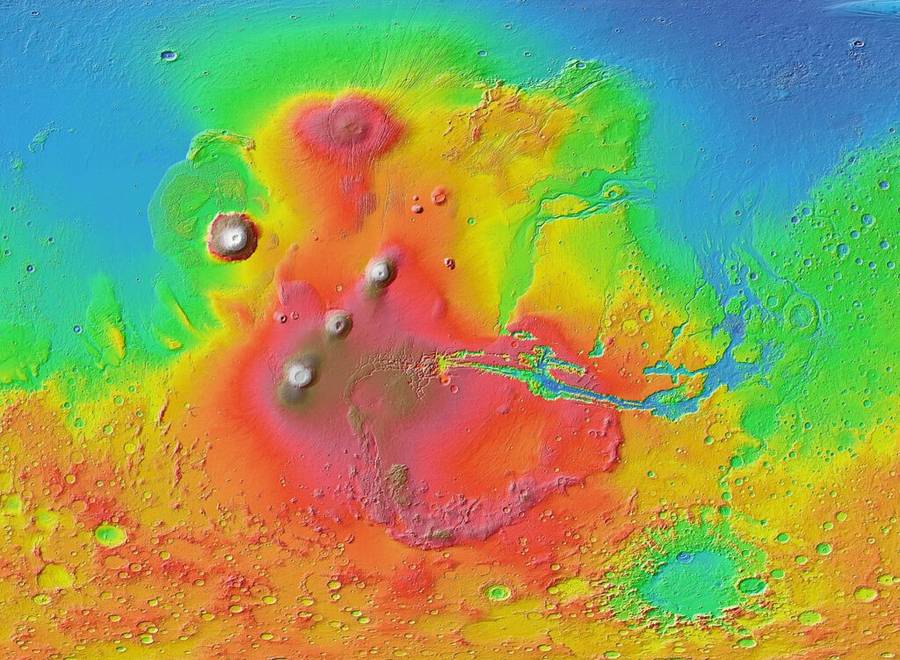O OVGA é um Centro de Ciência que desenvolve atividade de investigação aplicada e de divulgação científica na área da Vulcanologia, da Sismologia e da Geotermia.
Notícia -A A +A
The grandest canyon in the Solar System – a product of ancient Martian volcanism
Notícia OVGA 17-02-2021

Topographic map of the Tharsis region (red/brown area) and the Valles Marineris canyon identified in its eastern region (Image: NASA).
Volcanism is not confined to planet Earth and thanks to decades of revolutionary work by planetary scientists, we now have abundant evidence that volcanism exists on every terrestrial planet, on many of the moons and even some asteroid belts!
High resolution images released by NASA on Christmas Day 2020 have provided further insight into some of this extra-terrestrial volcanism, potentially revealing more clues to the volcanic past of the Red Planet.
Beyond Earth, volcanism appears in strange forms and in the most unexpected places – such as plumes spurting hundreds of kilometres into space from Jupiter’s moon Io, ice volcanoes on Pluto, known as cryovolcanism, and a shield volcanoes large enough to cover the entire state of Arizona (Mars’ Olympus Mons).
Decades of space exploration reveal that Mars has been reshaped by volcanism throughout its history. Although no eruptions have been observed, using indirect evidence from Martian meteorites found in Antarctica and rock samples collected by the Mars Exploration Program, launched in 2011, scientists now predict that volcanoes on the planet may have been active as recently as 1 million years ago – in geological terms, this is very young.
The most recent development in understanding and interpreting volcanism on Mars comes from the ground-breaking detailed images of the Valles Marineris (The Mariner Valley), utilising the HiRISE (High Resolution Imaging Science Experiment) onboard the Mars Reconnaissance Orbiter. Ten times longer than the Grand Canyon, Arizona, and three times as deep, the Valles Marineris cuts through the surface of Mars. This grandest canyon in the Solar System stretches 4,000 km across the Red Planet’s equator.
As described by NASA, the canyon extends from the Noctis Labyrinthus region in the west to the chaotic terrain in the east. Billions of years ago, Martian volcanoes in the Tharsis region near the present-day canyon erupted, consequently fracturing the crust. The canyon is in proximal distance to a vast volcanic plateau, home to the three largest volcanoes in the solar system. The erupted material then fell, forming the valley topography. Over geological time, it is thought that landslides and magma flows (together with escaping subsurface water and erosional forces) helped expand the massive planetary rift we now observe today. Since the ancient volcanism, and based on mineralogical information, scientists believe that strong water flows likely reshaped Valles Marineris, deepening the rift and creating the canyon topography now seen.
In February, a trio of spacecraft – from NASA, China, and the UAE – will arrive on Mars. Included in these flights is the first helicopter ever designed to fly on another planet. Mars has more volcanic secrets to share – and 2021 has the capacity to bring us new-found knowledge and more detailed images of the Red Planet.
Source: Volcano Discovery, 13 january 2021
